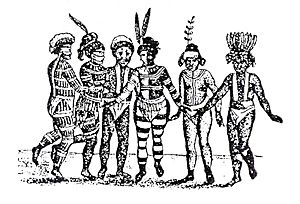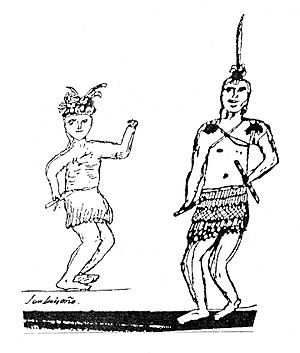California mission clash of cultures facts for kids
The California mission clash of cultures describes the big changes and challenges that happened when Spanish missions were built in California. This was during the time when Spain and later Mexico controlled California. These missions were religious outposts built by Spanish Catholic Franciscans from 1769 to 1823. Their main goals were to protect Spain's land and to convert California's Native Americans to Christianity.
However, the Spanish arrival in California also brought many difficult changes for Native American cultures and people. This included both groups directly in contact with missionaries and those who traded with them. Researchers have studied these negative effects more closely in recent years.
Contents
Spanish Era: Missions Begin
One of the first jobs for Spanish explorers in California was to learn about the native peoples. The Portolá expedition in 1769-70 was the first European land journey. It went as far north as San Francisco Bay. Several people on this trip wrote diaries. These diaries described how they met and observed the Native Americans. Juan Crespí, a Franciscan missionary, wrote the most detailed diary. Pedro Fages, a military officer, also wrote an important report.
Before building permanent missions, the priests needed to attract and convert many local Native Americans. These Native Americans would become the main workers at the missions. The priests offered things like beads, clothes, blankets, and food to attract them. They wanted them to move into the mission area or a nearby village.
Once at the mission, each Native American was expected to work. They spent many hours each week making adobe bricks or roof tiles. They also worked on construction teams or did handicrafts. Women wove cloth, cooked meals, and washed clothes. They were generally in charge of all household tasks at the mission.
Power and Leadership in Missions
The way power was set up in the missions caused many cultural problems. Missionaries gave authority to Native American officials. These officials often had power within their own tribes before the missions. But this new authority often went against their old cultural values.
Before the Spanish arrived, Native American societies in California had their own leaders. These leaders were often chosen by family line or cultural traditions. At the missions, however, leaders were chosen by elections. This new system was closely watched and often controlled by the Franciscans. This changed the traditional Native American social structure.
Native American officials at the missions often had to keep peace between missionaries and other Native Americans. This sometimes caused tension between the officials and their own people. Junípero Serra, a leading Franciscan, wrote about this. He wanted officials to do their duty to the missionaries. But he also wanted Native Americans to still respect the fathers.
In 1811, the Spanish Viceroy in Mexico sent a questionnaire to all missions in Alta California. It asked about the customs, feelings, and living conditions of the Mission Indians. The answers varied a lot. They were collected and sent to the government. These answers, even if incomplete or biased, are very helpful for modern researchers studying Native American cultures.
Native Americans at the missions also spent much time learning about Christianity. They attended worship services several times a day. Fray Gerónimo Boscana, a Franciscan scholar, lived at Mission San Juan Capistrano for over ten years. He wrote a very detailed study of the native religious practices in that area before the missions.
Mexican Era: Missions Change
Spain lost control of California and other lands after the Mexican War for Independence. This left the Spanish Franciscan missionaries managing the mission buildings. The new Mexican government often viewed these missionaries with suspicion.
The Mexican secularization act of 1833 officially ended the mission system. Much of the good farming land was given to Californios. These were people of Spanish descent who stayed in California. They often used Native American people for forced labor. This Mexican land grant period created many new ranches in California. These ranches were built on former mission and Native American lands.
Modern Research: Understanding the Past
In recent years, there has been much discussion about how Native Americans were treated during the Mission Period. Native American scholars say that the California Mission system directly led to a big drop in Native American populations.
For many years, people often believed that Native Americans enjoyed their new lives at the missions. It was thought that many could support themselves after the missions closed. This was supposedly because of skills they learned there. It was also said that Native Americans were often allowed to visit their villages. They supposedly took part in many ceremonies and celebrations with the missionaries' encouragement.
However, modern researchers now point to a different view. They say that the missionaries had a cultural bias. This bias made them unable to fully understand the difficult situation of the Native Americans. It also caused them to have strong negative opinions about Californian Native Americans.
New information shows the Native Americans' experiences in a very different way. For example, women were often housed separately from men, even if they were married. Also, Native American cultural and spiritual beliefs about marriage and love were often ignored or punished. Once a Native American joined the mission community, they were not allowed to leave without a padre's permission. From then on, their lives were very structured. They were taught "civilized" ways by the Spaniards. Native Americans were often subjected to physical punishment and other discipline chosen by the padres.
The decision to make Junípero Serra a saint still causes debate today. This is because of how Native Americans were treated by Franciscan missionaries. When Pope Francis announced he would make Serra a saint in 2015, a statue of Christ was damaged at Mission San Gabriel in Los Angeles. Also, a petition asking the Pope to learn about the "deception, exploitation, oppression, and mass deaths" of Native Americans received over 10,000 signatures.
Native American Population Changes
Before Europeans arrived, California's Native American population was about 225,000. This number dropped by about 33 percent during Spanish and Mexican rule. Most of this decrease was due to diseases.
Under American rule (starting in 1848), when most of the missions were in ruins, the loss of Native American lives was even worse. About 80 percent died, leaving only 30,000 in 1870. Nearly half of these deaths were due to violence, not just disease. Baja California also saw a similar drop in its native population because of Spanish colonization efforts there.
See also
 In Spanish: Choque cultural en las misiones españolas en California para niños
In Spanish: Choque cultural en las misiones españolas en California para niños



